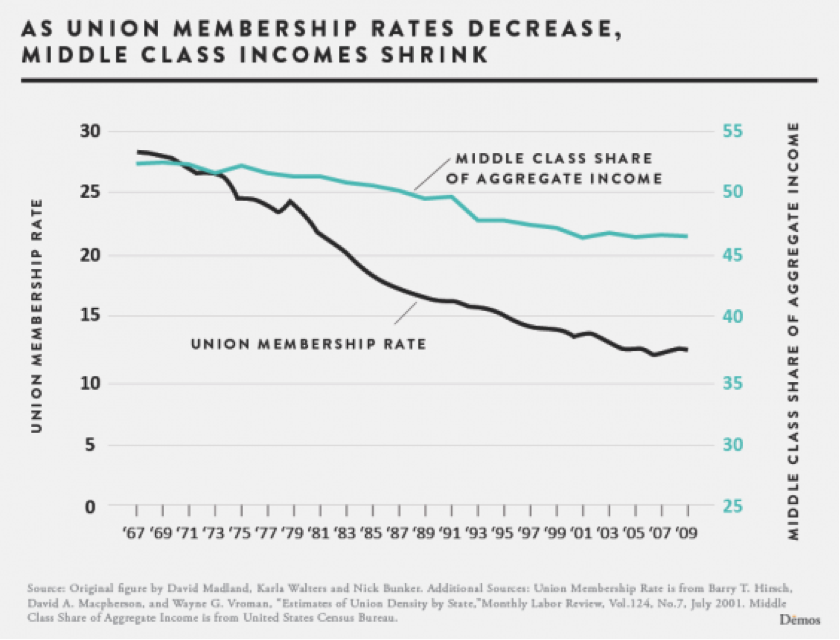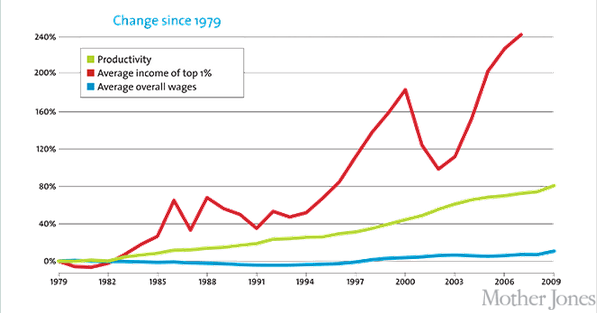America’s Productivity Climbs but Wages Stagnate
Post on: 16 Март, 2015 No Comment

FEDERAL income tax rates will rise for the wealthiest Americans, and certain tax loopholes might get closed this year. But these developments, and whatever else happens in Washington in the coming debt-ceiling debate, are unlikely to do much to alter one major factor contributing to income inequality. stagnant wages. For millions of workers, wages have flatlined. Take Caterpillar, long a symbol of American industry: while it reported record profits last year, it insisted on a six-year wage freeze for many of its blue-collar workers.
Wages have fallen to a record low as a share of America’s gross domestic product. Until 1975, wages nearly always accounted for more than 50 percent of the nation’s G.D.P. but last year wages fell to a record low of 43.5 percent. Since 2001, when the wage share was 49 percent, there has been a steep slide.
Related in Opinion
graphic
Anemic American Paychecks JAN. 12, 2013
Opinion: Can’t Save? Here’s Why JAN. 12, 2013
“We went almost a century where the labor share was pretty stable and we shared prosperity,” says Lawrence Katz. a labor economist at Harvard. “What we’re seeing now is very disquieting.” For the great bulk of workers, labor’s shrinking share is even worse than the statistics show, when one considers that a sizable — and growing — chunk of overall wages goes to the top 1 percent: senior corporate executives, Wall Street professionals, Hollywood stars, pop singers and professional athletes. The share of wages going to the top 1 percent climbed to 12.9 percent in 2010, from 7.3 percent in 1979.
Some economists say it is wrong to look at just wages because other aspects of employee compensation, notably health costs, have risen. But overall employee compensation — including health and retirement benefits — has also slipped badly, falling to its lowest share of national income in more than 50 years while corporate profits have climbed to their highest share over that time.
Conservative and liberal economists agree on many of the forces that have driven the wage share down. Corporate America’s push to outsource jobs — whether call-center jobs to India or factory jobs to China — has fattened corporate earnings, while holding down wages at home. New technologies have raised productivity and profits, while enabling companies to shed workers and slice payroll. Computers have replaced workers who tabulated numbers; robots have pushed aside many factory workers.
Related Coverage
News Analysis: The Low Politics of Economic Growth JAN. 12, 2013
“Some people think it’s a law that when productivity goes up, everybody benefits,” says Erik Brynjolfsson, an economics professor at the Massachusetts Institute of Technology. “There is no economic law that says technological progress has to benefit everybody or even most people. It’s possible that productivity can go up and the economic pie gets bigger, but the majority of people don’t share in that gain.”
From 1973 to 2011, worker productivity grew 80 percent, while median hourly compensation, after inflation, grew by just one-eighth that amount, according to the Economic Policy Institute, a liberal research group. And since 2000, productivity has risen 23 percent while real hourly pay has essentially stagnated.
Meanwhile, it’s been a lost economic decade for many households. According to the Center for Budget and Policy Priorities, median income for working-age households (headed by someone under age 65) slid 12.4 percent from 2000 to 2011, to $55,640. During that time the American economy grew more than 18 percent.
Emmanuel Saez. an economist at the University of California at Berkeley, found that the top 1 percent of households garnered 65 percent of all the nation’s income growth from 2002 to 2007, when the recession hit. Another study found that one-third of the overall increase in income going to the richest 1 percent has resulted from the surge in corporate profits.
MANY economists say the stubbornly high jobless rate and the declining power of labor unions are also important factors behind the declining wage share, reducing the leverage of workers to demand higher wages. Unions represent just 7 percent of workers in corporate America, one-quarter the level in the 1960s.

“There are very few occupations or industries where unions are strong enough where they can set standards,” says Lawrence Mishel, president of the Economic Policy Institute. “There are no standards being set, so companies can push down on wages for all workers, union and nonunion alike.” When the Detroit automakers secure two-tier contracts, that enables them to pay new hires $16 an hour, far less than the $28 an hour earned by longtime workers. This also pushes down labor’s share.
Pamela Waldron, a cashier at a KFC restaurant in Manhattan, earns $7.75 an hour after eight years on the job and says she last received a raise in 2007. “Being here eight years, I think I should be getting more,” she said. “You can fight for a raise, but I don’t think you’re going to get it.”
It is often thought that college graduates can escape these unfortunate wage trends. But college graduates — hit by the bursting of the tech bubble in the late 1990s and then by the deep recession — have been hit hard, too. Seventy percent of the nation’s college grads have had their after-inflation hourly wages decline since 2000, according to the Economic Policy Institute, with the typical graduate experiencing a 3.1 percent decline.
Jared Bernstein, who served in the Obama administration as executive director of the White House Task Force on the Middle Class, said many steps should be taken to increase labor’s income share, including raising the minimum wage, pushing down the jobless rate, enacting laws that make it easier for workers to unionize and increasing wage subsidies for those on the bottom. He also said the federal government, in spending hundreds of billions on health care, might insist that providers pay home-care aides or lab technicians $20 an hour rather than $10. “There’s no reason why a lab technician with a few years of community college shouldn’t be able to find her way into some segment of the middle class,” he said.
Professor Katz of Harvard said it would make sense to create a more progressive tax system when corporations and the top 1 percent are commanding more of the economic pie. He said those on top should agree to some redistribution and to invest in the next generation.
“We’ll end up with a larger pie, and they’ll be better off — even though they may think it clashes with their own self-interest,” he said.
Steven Greenhouse is a reporter on labor and workplace issues for The New York Times, and author of “The Big Squeeze: Tough Times for the American Worker.”
A version of this news analysis appears in print on January 13, 2013, on page SR5 of the New York edition with the headline: Our Economic Pickle. Order Reprints | Today’s Paper | Subscribe














